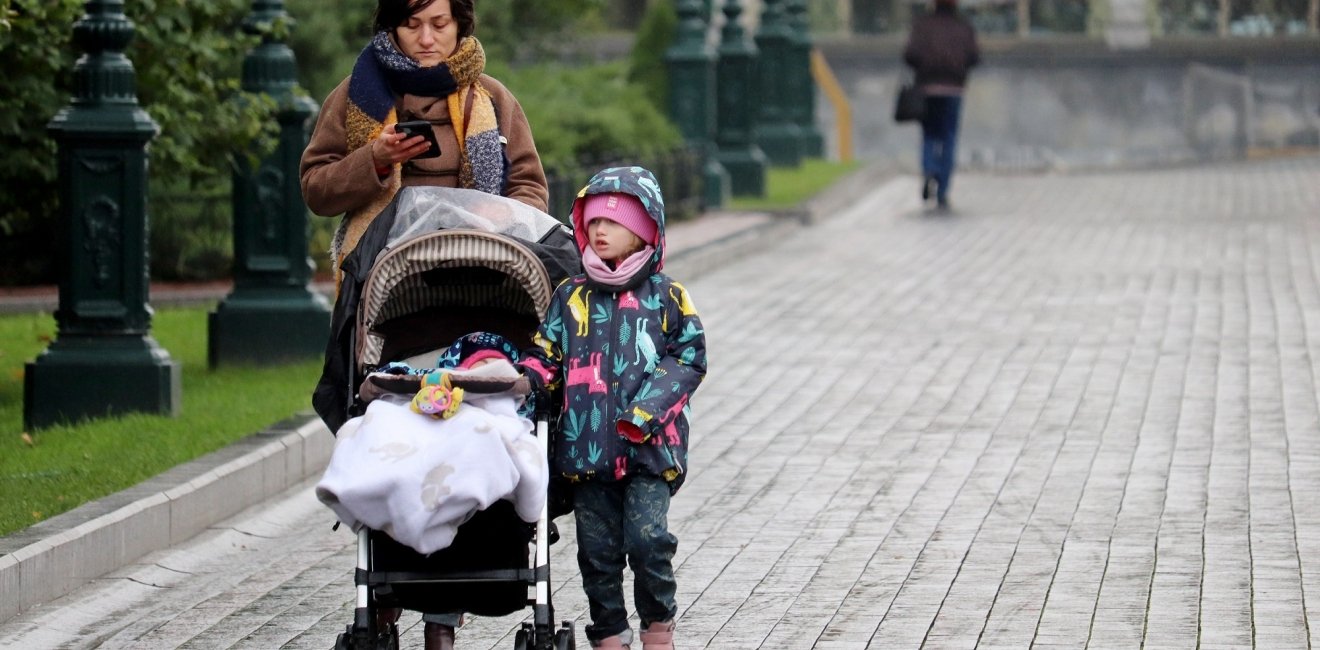
A blog of the Kennan Institute
BY NATALIYA SHOK
During its post-Soviet history, Russia has gone through a major paradigm shift in the state’s reproductive policies. Throughout the 1990s and 2000s Russian women gained more control over their sex lives as the Soviet family-oriented policies were phased out and better birth control options became available.
In the conservative shift that followed in the 2010s, Russia’s ruling politicians sought to raise the country’s fertility rates and started to promote traditional family values and restrict access to abortion, an operation that has been normalized since the Soviet era. Access to surrogacy, a controversial subject in many countries, has not been curbed, however, and remains poorly regulated.
These two issues resonated unexpectedly in 2020, exposing Russia’s political contradictions and previously hidden levels of female inequality and reproductive vulnerability. Russia’s current reproductive policy is a consequence of historical inconsistencies and a reflection of the state of medical ethics and public health in Russia.
Deprived of agency in reproductive matters, Russian women are the object rather than the subject of the government's demographic policies. In this area, the Russian public discourse reproduces Western cultural wars between liberal and conservative agendas, even though a wide range of reproductive options are actually available to Russian women. The problem is, however, that the essence of reproductive rights as individual rights and freedoms is not acknowledged by the Russian officials, who treat infertility as the only meaningful problem, while disregarding the ethical dilemmas, such as the power imbalance and economic inequality associated with commercial surrogacy.
Mobilizing a Rhetoric of “Family Values” in the Service of Declining Demographics
The USSR was one of the first countries in the world to legalize abortion in 1920 as part of the Bolshevik regime’s radical emancipation stance. Whereas contraception in the Soviet Union was barely accessible, abortion was readily available on a mass scale. It was not publicly encouraged but was, de facto, the most widely used “birth control” method. Soviet women learned to see abortion as a routine operation and a woman's inalienable right, while women from the West, including the United States, would travel to the socialist countries of Eastern and Central Europe to have abortions performed. Even today, Russia’s abortion regulation is more liberal than that of the United States or Poland.
The situation with surrogacy is similar. After the United States, Russia is the second largest—and much more accessible—market for it. Russian women obtained the right to artificial insemination and embryo implantation in 1993. In 2003 the Russian Ministry of Health defined the term “surrogacy” as a method of “therapy for female and male infertility.”
On January 20, 2021, parliamentary hearings were held to discuss a bill regulating surrogacy. One of the sponsors, Petr Tolstoy, the deputy speaker of the Russian parliament, stated that the legislation in this area should be based on “traditional ideas about family values, motherhood and childhood.” The bill’s mission was not to ban surrogacy but to stop the “flow of children who are taken away from Russia,” Tolstoy added. The protection of reproductive health and the rights of surrogate mothers, the exploitation of women, and the female social inequality in Russia that economically underpins the practice of surrogacy were not articulated.
The proposed amendments, which would ban foreign nationals and single Russian parents from using surrogacy services, have drawn criticism from lawyers and the medical community. The current official discourse on the subject often references the safety of children and legal, religious, demographic, and economic factors but elides women’s agency in reproductive matters.
The public outcry started in January 2020 when a newborn child died of unknown causes in a rented apartment in a town near Moscow. The boy was the son of a Filipino businessman who used the services of a Russian surrogate mother. Last summer, the Russian Investigative Committee interpreted a story of two foreigners taking their newborn child from a Russian surrogate mother as an instance of human trafficking, and initiated a criminal case. This was the result of a poor regulatory framework for surrogacy and the lack of legal protection for all participants in the process. Assisted reproductive technologies, and especially surrogacy, are in a gray area as they are not issues that are publicly discussed in Russian society—quite the opposite.
Inconsistent Policies and Borrowed Cultural Wars
Last year Oleg Apolikhin, a physician reproductive specialist with the Russian Ministry of Health, suggested removing abortions from the public health care system and making them the responsibility of the Federal Penitentiary Service. His reasoning? “An abortion without medical indication is a kind of execution,” he said. Currently, abortion is on the list of medical procedures covered by compulsory health insurance at the government’s expense. The topic has been repeatedly raised by representatives of the Russian Orthodox Church. Abortion opponents argue that limiting abortion would help alleviate the demographic crisis and contribute to the government’s goal of raising fertility rates.
Contradicting its own representative, Apolikhin, however, the Russian Ministry of Health has indicated that abortion should remain within the public health system, noting that much is already being done today to prevent unnecessary abortions. Women are entitled to consultations with psychologists, and the list of indications for abortion has been reduced. Abortion rates in Russia have been going down for decades now but, at 56 per 100 births, Russia is still among the world’s leaders. (For comparison, Russia’s abortion rate was over 200 per 100 births in 1990.)
The rhetoric against abortion and against surrogacy are intertwined. Both phenomena are discussed in the context of sex education programs, reproductive health, access to quality obstetric and gynecological care, fertility trends, the position of women in society, and behavioral reproductive strategies. Russia’s peculiarity is that the right to abortion and the right to artificial insemination did not emerge as a result of women’s struggle for civil rights but are the products of government policies.
According to the demographer Victoria Sakevich, Russia’s reproductive policy has not been consistent. She has divided the post-Soviet period into three parts, characterizing the years before 1998 as “auspicious for family planning,” those from 1998 to 2006 as “moderately inauspicious,” and those from 2006 on as a time of “archaization and regression” in the policy realm.
In Russia, liberal attitudes toward surrogacy, access to abortion, rapid state-funded development of assisted reproductive technologies and genetic research, the conservative “abortion is murder” view, and the active role of religious communities all come together in a bizarre combination. Today, Russian cultural battles simultaneously mobilize a memory of national historical ruptures, the borrowed rhetoric of pro-life activists, liberal bioethics terminology, and the Soviet history of demographic policies.
A Discursive Divide between Policy and Practice
Russian politicians are completely insensitive to these discursive divides. It is as if they do not notice the difference between the imported concept of biomedical ethics, shaped by American culture, and the legacy of Soviet medical deontology that persists in Russian medical practice and health policy today. The conservative reproductive attitudes of Russian politicians do not resonate with society. Abortion and surrogacy are socially approved practices, public opinion polls suggest. One of the main hurdles to having children, as in Soviet times, is seen by Russians as a lack of material resources for raising a child.
Public debates about abortion and surrogacy illustrate the deep discursive gap between state reproductive policy and the reproductive strategies of Russians themselves. The lack of birth control options in the past made abortion routine. Today, the lack of state support for families and women has created the preconditions for the spread of such social practices as surrogate motherhood. How does a woman benefit from it? Most often, it is a chance to have a child, on the part of the woman seeking a surrogate, and the ability to pay for a family's basic needs (loan payments, relocation expenses, children's education, etc.) on the part of the surrogate. Today, the government’s emphasis on increasing fertility rates has resulted in increased funding for assisted reproductive technologies rather than early prevention of infertility, sex education, or better support to families with children.
The year 2020 marked the 100th anniversary of legalized abortion in Russia. It was also a year when Russian women’s vulnerabilities were exacerbated by the global pandemic. The Russian health care system has been relatively efficient in fighting the coronavirus, and its innovative potential has been demonstrated by the successful development of vaccines. However, prioritizing the public good over individual choices works only in a situation in which the government needs to fight a dangerous infectious disease by placing temporary restrictions on some personal freedoms. That strategy should not be applied to reproductive policies, where individual autonomy is of paramount importance. Disregarding the principles of reproductive ethics, and socio-economic determinants of women’s reproductive choices and behavior undermines their health, rights, and equality and may have long-lasting negative effects on individual lives and families and on public health in general.
The opinions expressed in this article are those solely of the authors and do not reflect the views of the Kennan Institute.
Author

Independent Analyst

Kennan Institute
After more than 50 years as a vital part of the Wilson Center legacy, the Kennan Institute has become an independent think tank. You can find the current website for the Kennan Institute at kennaninstitute.org. Please look for future announcements about partnership activities between the Wilson Center and the Kennan Institute at Wilson Center Press Room. The Kennan Institute is the premier US center for advanced research on Eurasia and the oldest and largest regional program at the Woodrow Wilson International Center for Scholars. The Kennan Institute is committed to improving American understanding of Russia, Ukraine, Central Asia, the South Caucasus, and the surrounding region through research and exchange. Read more

Explore More in The Russia File
Browse The Russia File
Chechnya as a Model of Modern Russia

Russia’s Indigenous Communities and the War in Ukraine

Gas and Power in a Changing US–Russia Relationship

